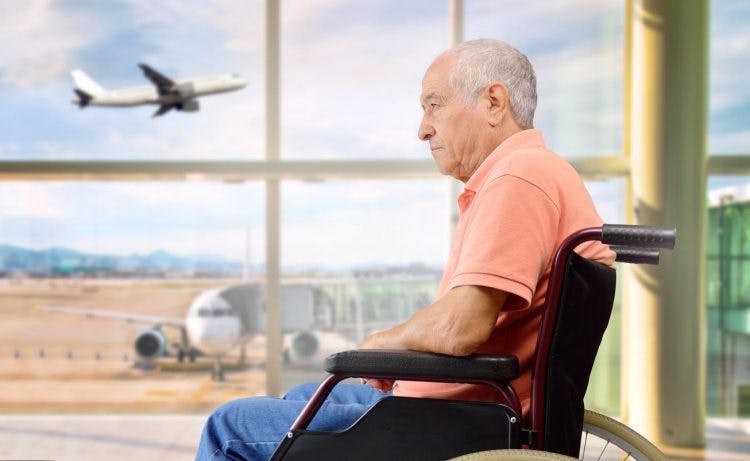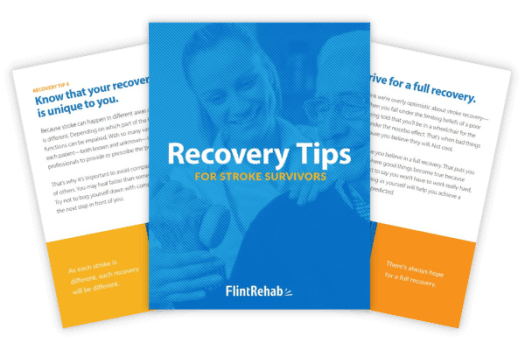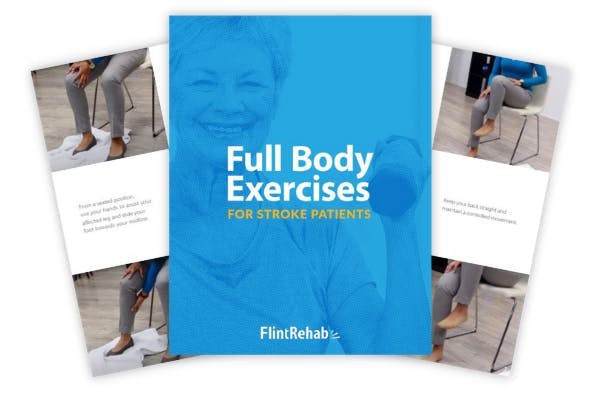No products in the cart.
No products in the cart.
No products in the cart.
No products in the cart.
Home » Neurological Recovery Blog » Stroke » Flying After Stroke: How Long to Wait + Tips for Safe Travel
Last updated on January 15, 2024

Flying after stroke is a common concern for many stroke survivors. A stroke is a serious medical event often accompanied by many secondary effects. Stroke can lead to changes in physical function, decreased mobility, and fear of experiencing another cerebrovascular event. As a result, stroke survivors may have concerns about air travel in the future and questions about flying after stroke such as:
How long after a stroke can I fly? What medical conditions make flying unsafe? Does flying increase my risk of another stroke, and what happens in the worst-case scenario?
These are all valid questions for anyone hoping to fly after a stroke. Thankfully, there are some general guidelines for stroke survivors interested in flying to ensure safety and increase peace of mind. To help prepare you for safe travel, this article will review these guidelines for flying after a stroke as well as provide helpful tips and tricks to make your journey as stress-free as possible.
Stroke survivors often ask, how soon is it safe to fly after a stroke? According to the Stroke Association, it is best to wait at least two weeks to fly following a stroke. This is because a person is at an increased risk of a second stroke after suffering a TIA (transient ischemic attack) or stroke.
In the event of a second stroke, it is advisable to be close to emergency medical interventions that can reverse the stroke effects, such as the administration of medications like TPA. Lastly, sometimes new post-stroke medical conditions may arise within a few months of the initial stroke. In this case, it is best to be near your medical providers to receive medical attention if needed.
Every stroke is different, so getting clearance from your doctor before you fly is important. They can determine if you are medically stable enough to participate in air travel. Otherwise, it’s best to remain near home, where medical attention is quickly and easily accessible. If your travel plans are flexible, waiting 1-3 months to travel after a stroke is best.
By understanding the risks of flying after a stroke, you can have an informed discussion with your doctor about when it’s safe to fly again. Here are some complications that can accompany flying after stroke.
Hypercoagulability is an increased tendency for your blood to form clots. Flying increases your body’s tendency to form clots. These clots are the cause of ischemic stroke which takes place when an artery in the brain becomes blocked by a blood clot.
The risk of developing a blood clot is increased during and after air travel, according to many research studies. In fact, long flights can elevate clot risk by 26%.
Inactivity in cramped spaces on flights can lead to blood clots developing in the legs. A deep vein thrombosis (DVT) is an example of this and occurs when a blood clot forms in the leg. Small pieces of this clot can also break loose and travel to clog an artery in the lungs, causing a life-threatening condition called pulmonary embolism, or it can travel to the brain, causing a stroke.
The air pressure is lower on a plane, which means less oxygen is available to fuel your body, including the brain. During stroke recovery, oxygen is critical for recovery (see: oxygen therapy for stroke), so it’s best to avoid sitting in an environment with less oxygen for prolonged periods of time.
Although reduced oxygen levels while flying are unlikely to pose a risk for survivors of stroke, this can be an issue for those with comorbidities such as breathing difficulties or a heart condition. Again, it is best to speak with your doctor to determine if flying is a safe option for you.
If you were to experience a stroke on a plane, the pilot may attempt to make an emergency landing to get you the emergency medical attention you need. Although lives have been saved by emergency landings before, the time it takes for you to receive appropriate treatment may still be prolonged.
Some of the interventions for stroke such as TPA (tissue plasminogen activator) must be administered promptly. This is why many doctors suggest waiting for a certain period before flying after a stroke.
Overall, the incidence of stroke while flying is low, but it is still important to exercise caution and follow the advice of your medical team. Now that we have reviewed the flying risks, let’s discuss how to make your trip as safe as possible if you decide to fly after stroke.
Although travel is exciting and creates new opportunities, it can be stressful or overwhelming at times. This may be especially true for survivors of stroke, especially if you’ve experienced changes in mobility or are concerned about the risks of flying.
However, there are many things you can do when flying to help decrease the risk of developing a clot and reduce travel stress. If you have been cleared to fly after stroke, here are some tips to improve your safety and well-being:
Although the risk of a recurrent stroke is a concern for all survivors, flying increases this risk and should be considered carefully, especially in the first 6 months to a year after a stroke. Overall, it’s up to your doctor to decide if and when it is safe for you to fly after a stroke. Everyone has different risk factors and medical complications that may require a greater waiting period before flying.
When you receive medical clearance, make sure you are prepared for travel and are aware of airline and destination guidelines regarding your health status and medications. Take precautions like wearing compression stockings, moving frequently, and allowing for additional time to reach your gate. These give you peace of mind so you can enjoy your trip.
We hope this article has helped educate you on the risks of flying after a stroke, the importance of consulting your medical team, and different tips to help keep you safe during travel. Your health is the most important factor, so exercise good judgment and enjoy your travels.

Get our free stroke recovery ebook by signing up below! It contains 15 tips every stroke survivor and caregiver must know. You’ll also receive our weekly Monday newsletter that contains 5 articles on stroke recovery. We will never sell your email address, and we never spam. That we promise.


Do you have these 25 pages of rehab exercises?
Get a free copy of our ebook Full Body Exercises for Stroke Patients. Click here to get instant access.
“My name is Monica Davis but the person who is using the FitMi is my husband, Jerry. I first came across FitMi on Facebook. I pondered it for nearly a year. In that time, he had PT, OT and Speech therapy, as well as vision therapy.
I got a little more serious about ordering the FitMi when that all ended 7 months after his stroke. I wish I hadn’t waited to order it. He enjoys it and it is quite a workout!
He loves it when he levels up and gets WOO HOOs! It is a wonderful product! His stroke has affected his left side. Quick medical attention, therapy and FitMi have helped him tremendously!”
FitMi is like your own personal therapist encouraging you to accomplish the high repetition of exercise needed to improve.
When you beat your high score or unlock a new exercise, FitMi provides a little “woo hoo!” as auditory feedback. It’s oddly satisfying and helps motivate you to keep up the great work.
In Jerry’s photo below, you can see him with the FitMi pucks below his feet for one of the leg exercises:
Many therapists recommend using FitMi at home between outpatient therapy visits and they are amazed by how much faster patients improve when using it.
It’s no surprise why over 14,000 OTs voted for FitMi as “Best of Show” at the annual AOTA conference; and why the #1 rehabilitation hospital in America, Shirley Ryan Ability Lab, uses FitMi with their patients.
This award-winning home therapy device is the perfect way to continue recovery from home. Read more stories and reviews by clicking the button below:
Grab a free rehab exercise ebook!
Sign up to receive a free PDF ebook with recovery exercises for stroke, traumatic brain injury, or spinal cord injury below: